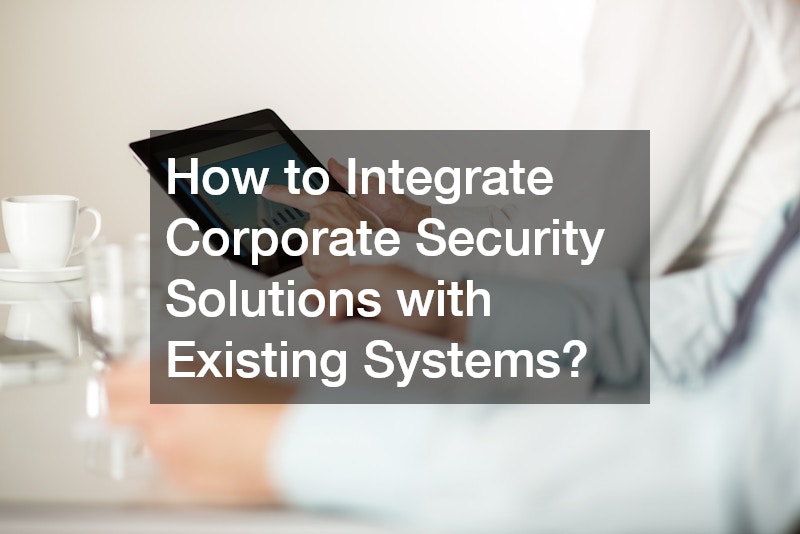In today’s evolving business landscape, ensuring the security of corporate assets has become more critical than ever. Threats, both physical and digital, have increased in sophistication, putting immense pressure on businesses to protect their people, property, and data. A robust corporate security solution serves as the foundation of any well-structured company, addressing potential risks and vulnerabilities in a holistic manner. This guide covers the key elements of corporate security solutions, addressing common questions about implementing and selecting the right solutions for your business.
What are the Key Components of a Corporate Security Solution?
Corporate security is multifaceted, encompassing physical security, cybersecurity, and personnel training. Here, we break down the essential components to provide an in-depth look at what a solid corporate security solution entails.
Understanding Physical Security Measures
Physical security remains fundamental in any corporate security strategy, preventing unauthorized access to premises and protecting tangible assets. From hiring a reputable alarm system company to installing security barriers like a 5 point security door, businesses can reinforce their boundaries. Physical security also includes access control systems, surveillance cameras, and secure lock mechanisms to ensure only authorized personnel can enter sensitive areas.
Exploring Cybersecurity Essentials
With data being an invaluable asset, cybersecurity is a major component of any security solution. Corporate security solutions should include firewalls, antivirus software, intrusion detection systems, and multi-factor authentication. Additionally, businesses should work with a local electrician to ensure network wiring and electrical infrastructure are secure, preventing breaches that could arise from physical access to IT systems.
The Role of Personnel Training in Security
Employees are often the first line of defense against security breaches. A corporate security solution must encompass personnel training on security best practices and awareness of potential risks. Employees should be educated on how to recognize phishing attempts, maintain password hygiene, and follow protocols to report security incidents.
Leveraging Technology for Enhanced Security
Advances in technology have enhanced security options available to businesses. Video surveillance, biometric access controls, and automated alarm systems offer comprehensive monitoring. Partnering with a commercial generator provider ensures that security systems remain operational during power outages, further supporting continuous protection.
Integrating Security Policies and Procedures
A strong corporate security solution is supported by comprehensive policies and procedures. These rules should outline acceptable use of company assets, guidelines for securing devices, and protocols for incident response. Policies ensure that every member of the company understands their responsibilities regarding security.
How to Choose the Right Security Provider for Your Business?
Selecting the right security provider is crucial for effective implementation of security measures. This section outlines the criteria to consider when choosing a corporate security provider.

Evaluating Different Security Vendors
When choosing a security provider, assess various vendors to determine which can best meet your needs. Look for vendors with a proven track record, and be cautious of those offering quick fixes without proper assessments.
Determining Your Specific Security Needs
Each business has unique security needs based on its industry, size, and assets. Conduct a risk assessment to understand your requirements. Commercial locksmith services can provide customized lock installation for sensitive areas, while a custom door company can offer security doors tailored to your building’s structure.
Assessing Cost versus Benefits
Cost is a significant factor, but it shouldn’t be the sole determinant. Weigh the benefits against the costs, keeping in mind that a comprehensive security system can prevent costly breaches and loss of assets.
Checking References and Credentials
Research the credentials and references of potential security providers. Look for certifications and client testimonials. Additionally, consulting a lawyer familiar with criminal law may help in understanding the legality and regulatory compliance of your chosen provider’s solutions.
Ensuring Alignment with Business Objectives
Your chosen security provider should align with your business’s mission and values. Security measures should not hinder daily operations but instead support a safe and productive environment.
What Are the Latest Trends in Corporate Security?
Staying current with security trends enables businesses to address emerging threats proactively. Here are some notable trends in corporate security today.
Adopting Artificial Intelligence and Machine Learning
AI and machine learning are transforming security, enabling predictive analysis to detect and respond to potential threats before they escalate. These technologies streamline incident response and offer data-driven insights into security practices.
Implementing Cloud-Based Security Solutions
Cloud-based solutions are growing in popularity, as they allow businesses to store data securely and enable remote access to security controls. However, cloud security requires robust measures to protect against unauthorized access and data breaches.
Focusing on IoT Security Challenges
With the rise of IoT devices, the attack surface for hackers has expanded. It’s essential to secure IoT-connected devices, often with the assistance of a local electrician for appropriate installation, ensuring they do not become access points for cyberattacks.
Embracing Blockchain for Secure Transactions
Blockchain technology is being adopted for secure, verifiable transactions, reducing the risk of fraud and ensuring transparency. While primarily used in finance, blockchain has applications in verifying data integrity across various industries.
Prioritizing Employee Awareness and Training
Continuous employee training is essential to maintain high-security standards. Employees should be educated on new threats, such as social engineering and data privacy practices, ensuring a culture of security awareness.
How Can Small Businesses Implement Effective Security Solutions?
Smaller businesses often face budget constraints, but they can still implement effective security measures with these strategies.

Identifying Low-Cost Security Measures
For businesses on a budget, simple measures like reinforced doors, impact windows, and secure locks offer significant protection without extensive costs.
Utilizing Off-the-Shelf Security Software
Off-the-shelf software solutions provide cost-effective protection for small businesses. Many vendors offer scalable options, allowing businesses to upgrade as they grow.
Formulating a Scalable Security Plan
Small businesses should focus on developing a security plan that can scale with growth. By choosing solutions that can adapt, they can avoid costly upgrades in the future.
Partnering with Managed Security Service Providers
Outsourcing to managed security providers can be a viable option for small businesses, as these providers offer expertise and technology at a fraction of the cost of in-house security teams.
Training Staff on Security Best Practices
Small businesses can greatly enhance security by training staff on best practices. A well-informed team is an effective line of defense against a variety of security threats.
How Do Corporate Security Solutions Protect Against Cyber Threats?
Corporate security solutions play a vital role in safeguarding businesses from cyber threats. Here are some essential steps in a robust cybersecurity strategy.
Implementing Firewall and Antivirus Software
Firewalls and antivirus software provide the first line of defense against external attacks. These tools prevent unauthorized access and protect company data from malware.
Securing Network Infrastructure
Protecting network infrastructure is crucial for cybersecurity. Partnering with a local electrician to ensure physical network security and working with IT specialists to maintain cybersecurity measures like data encryption enhances network resilience.
Conducting Regular Security Audits
Regular audits reveal vulnerabilities within the security system, allowing businesses to address weaknesses proactively. Security audits also help ensure compliance with regulatory standards.
Deploying Intrusion Detection Systems
Intrusion detection systems monitor for unauthorized access attempts. When coupled with alarm systems, they offer real-time alerts that enable a swift response to potential security breaches.
Providing Employee Cybersecurity Training
Employees should receive training on cybersecurity practices, such as recognizing phishing scams and safeguarding company devices. Training ensures employees contribute to the security efforts rather than becoming potential vulnerabilities.
What is the Role of Corporate Security Solutions in Regulatory Compliance?
Compliance with security regulations is essential for many businesses, as failing to meet standards can lead to legal and financial repercussions.
Understanding Compliance Requirements
Each industry has its own compliance requirements. Corporate security solutions help businesses meet these requirements by providing data protection and accountability measures.
Implementing Data Protection Measures
Corporate security solutions should include encryption, access controls, and data storage policies that adhere to compliance requirements for safeguarding customer information.
Conducting Compliance Audits
Regular compliance audits identify any lapses in meeting regulatory standards, ensuring that security practices align with legal requirements.
Maintaining Documentation and Reporting
Documentation is essential for compliance, and corporate security solutions should include record-keeping for security incidents, audits, and policy changes.
Partnering with Compliance Experts
For industries with complex regulations, partnering with compliance experts helps ensure that all security measures meet legal requirements. A lawyer specializing in compliance can offer additional guidance on best practices.
How to Integrate Corporate Security Solutions with Existing Systems?
Integrating new security solutions with existing systems can be challenging. Here are steps to ensure a smooth integration.

Assessing Current Security Infrastructure
Understanding the current state of your security infrastructure helps identify gaps and ensure new solutions are compatible.
Identifying Integration Challenges
Recognize potential challenges, such as system incompatibility, and address them before implementation. For example, consulting with a commercial locksmith service or IT specialist may reveal physical and digital access points that require special integration solutions.
Using API and Middleware Solutions
API and middleware solutions enable seamless integration between security systems, ensuring all components work together efficiently.
Testing and Monitoring Integrated Systems
Regular testing and monitoring help identify any issues in the integrated systems, allowing for prompt resolution before security risks arise.
Ensuring Seamless User Experience
A seamless user experience minimizes friction and ensures employees can navigate security protocols without compromising productivity.
What Are the Practical Steps for Developing a Security Risk Management Plan?
Developing a comprehensive risk management plan is vital for corporate security.
Identifying Potential Security Risks
Begin by identifying potential risks, both internal and external. These might include unauthorized access, cyber threats, and physical breaches.
Conducting Risk Assessments and Analysis
Conducting assessments and analyzing risks allows businesses to understand their vulnerabilities, prioritizing which risks to address first.
Implementing Risk Mitigation Strategies
Risk mitigation strategies, such as improved lock installation and security policies, minimize the likelihood of security incidents.
Regularly Reviewing and Updating the Plan
As the business environment changes, regular reviews of the risk management plan are necessary to stay current with new security threats.
Ensuring Employee Adherence to the Plan
Employee compliance is crucial for effective risk management. Provide regular training and communicate updates to ensure alignment with security protocols.
How to Evaluate the Effectiveness of Corporate Security Solutions?
Regular evaluation of security solutions ensures they remain effective in protecting corporate assets.

Setting Clear Security Metrics
Establish clear metrics to evaluate security performance, including incident response times, number of breaches, and employee adherence.
Conducting Performance Evaluations
Performance evaluations assess the effectiveness of security measures, identifying areas for improvement.
Analyzing Incident Reports
Incident reports provide insights into security weaknesses and help refine future security measures.
Leveraging Feedback from Stakeholders
Stakeholders offer valuable insights, and their feedback helps shape security strategies.
Adjusting Strategies Based on Lessons Learned
Lessons learned from past incidents should inform future strategies, ensuring continuous improvement.
How to Ensure Employee Buy-in for Security Initiatives?
Employee support is essential for a successful security strategy. Here’s how to encourage buy-in.
Communicating the Importance of Security
Clearly communicate why security measures are essential, emphasizing the role of each employee in maintaining security.
Providing Ongoing Security Education
Regular training sessions keep security top-of-mind for employees, reducing the likelihood of breaches.
Creating a Security-Conscious Culture
Fostering a culture of security encourages employees to take personal responsibility for safeguarding company assets.
Incentivizing Security Best Practices
Incentivize adherence to security protocols through rewards and recognition.
Encouraging Open Communication about Security Concerns
Allowing employees to voice concerns helps identify potential vulnerabilities and reinforces a security-conscious culture.
Corporate security solutions play an integral role in protecting business assets, maintaining regulatory compliance, and ensuring employee safety. By understanding the key components of security, staying informed about emerging trends, and fostering a security-focused culture, businesses can create a safe, resilient environment. Embracing comprehensive, integrated solutions and prioritizing employee training and engagement are vital steps in safeguarding a business’s future. Furthermore, as new threats emerge, proactive assessment and adaptability are essential to maintain security effectiveness. Businesses should continuously review and refine their security strategies, using incident feedback, audits, and employee input to strengthen defenses and build a sustainable, secure foundation for growth.

